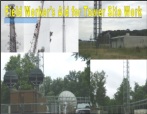As we approach 2019, I see some serious issues for the deployment labor force. There will be a shortage of tower workers and integration engineers. It will run through 2021. This bottleneck will put a deep strain on the workforce that has been maintaining for the past several years. This is a workforce that is limited. Site work is a limited skill set as well as a limited workforce. It also has been beaten down by the carriers to remove many of the highly qualified seasoned craftsmen that were once synonymous with this industry. Now it has a younger and inexperienced workforce. All of this and a mentality that they will be used while needed then immediately disposed of once the industry work tapers off. They could get laid off, fired, or abandoned. It all happens in the wireless site business. This is typical of the wireless carrier business. It is feast or famine, meaning that all the work hits at once, then most of it disappears. That is the issue here, the slow business has put a downturn on the field workers causing the industry to downsize. While this is like construction, the carriers determine the workload, not the end-user. Unlike construction, it is not as steady nor does it turn out that all workers can migrate to another part of the business. Each part of the business has specific skill sets.
Sign up for HostGator Today!
Trust me; I have been there. I talked to many of these people, and I see what goes on. While AT&T’s turf system initially was great for the investors, it really changed the face of the tower climbing workforce for the worse. To be honest, that is why I got out. It was hard to climb towers for less money every year. Low bidder generally wins. That and the cost to do business was going up. Let’s explore.
When the turf system came along, it gave hope to local climbers. Any national climbing company has a hard time ramping up and moving crews across the country while maintaining a stable workforce. Smaller crews are generally in the market or within 4 hours of a market. Remember when AT&T’s projection of tower work a few years ago was driving companies to ramp up only to have it all disappear? I do. When that didn’t pan new climbers got laid off, and the larger companies had to discontinue training and scale back. It was a disaster.
I want to give my condolences to the family of Melvin Ronnie Nelson, Jr., who died April 2nd, 2018, working on a tower for Verizon. He was 34 years old from Foley, Alabama. The tower was being erected in Utica, Mississippi. My prayers go out to him and his family. To learn more go to Wireless Estimator . To make a difference, make a contribution to the Hubble Foundation. We all feel terrible when a fellow wireless workers dies, especially on the job.
Now, we see the need for climbers again. The problem is the climbing end of it doesn’t seem so lucrative as it once did. Will the crews be able to get more money based on supply and demand? Will they be able to get a good year in with plenty of work? I hope so. The way it looks, 2019 and 2020 should be big years for field work. On the tower and on the ground. While the RF engineering work is done more and more by programs, we still need workers to go out and do the site work. It’s still a necessity.
Will there be enough workers? Of course not. There is no way they can do all the work that is coming, based on projections. All the major carriers in the US are looking to do changes at tower sites and roll out small cells. They all need to deploy more LTE, massive MIMO, and 5G. It’s fixed and mobile wireless. It’s a lot of work.
Don’t forget the fiber workers; they will need to make changes to keep up the expansion. The workforce extends beyond the field, it will be a drain on upgrading the backhaul as well as all utilities.
It’s going to be busy, but the tower industry is not ready. I am glad that they will get plenty of work, but they need to be safe. It is a dangerous job. The issue with the carrier work is that the safety requirements are high, the schedule is tight, the closeout is slow, and it takes a long time  to get paid in some cases. All reason NOT to work for many carriers or their turf vendors. It’s tough to float money, whether it’s to pay for your workers or to pay your contractors. The carriers will need to understand this. They need to do their part if they want quality work.
to get paid in some cases. All reason NOT to work for many carriers or their turf vendors. It’s tough to float money, whether it’s to pay for your workers or to pay your contractors. The carriers will need to understand this. They need to do their part if they want quality work.
We need safety and proper training, that is number one! Let’s not cut back there. Although, it takes time to train people properly and to match the experience on a crew with the inexperienced. Planning, patience, and training. Be careful when doing this. Most experienced crews want to keep their crew. Most companies don’t want to pay 5 guys when 4 can do the job, even if the fifth guy is to be learning the job. They want all of them to be working and productive.
So, what can the industry do? Good question. They should get busy planning and roll out now, but we all know that the product may not be ready or that more planning is needed. Probably not going to happen that soon.![]()
Try to reserve crews? I don’t think any crew would sit and wait or stay if there is more money to be made with another contractor. Why wait and hope to get paid? Why leave money on the table? Go do the work and get paid.
As always, payments will be an issue. That has been the biggest issue in the industry, yet it seems to be the dirty secret no one wants to talk about. Why? Because if you don’t’ get paid, it becomes an issue of pointing fingers. Let’s face it; if you don’t pay, then the contractor will say you didn’t do your job.
What to look out for? Here are some tricks that screwed climbing crews in the past.
- The GC, general contractor, will not give the crew all the parts they need to finish the job, and they say they will only pay when the job is finished. Then, as the contractor leaves to wait for the missing parts, the GC gives the parts to another crew and has them finish the work in a day. Why? Because they only pay the second crew for a day’s work and they don’t pay the first crew anything because they didn’t finish the job.
- When jobs are winding down, GCs have let crews on a job, and just no paid, leaving the crews to fend for themselves. I have heard horror stories about how the GC would not pay for the expenses that were incurred.
- Some GCs will pay partial payments and tell the crews that they will pay if the crew does the next job, then another, until they have exhausted their expense money and then the GC won’t pay because they know the crew, generally a small company, will go out of business before they can sue the GC.
I know, these are terrible, yet very common in the industry. Don’t worry too much, many crews protect themselves and have systems in place to prevent this from happening. They often plan and have someone who is good with the paperwork. You must protect yourself.
It’s not all roses for the GCs; they have to deal with crew shortages and crews that don’t show. They must deal with crews leaving their jobs to go to a higher bidder. They will leave your job to make a few hundred more dollars with another GC. It’s going to get competitive out there.
Then there are crews with specific skill sets, like welding and structural modifications, they always cost more because they can do what other crews can’t.
What can you do to protect yourself? Let’s look at some ideas.
- If you’re an individual, then make sure you have a contract stating your terms of It’s best to get it in writing. Many times, companies will not hire W2 employees but 1099 climbers. This is where problems can begin. They technically may be run like a W2 worker, which opens legal issues.
- If the crew is under contract, they should have a clear scope of work for the specific job and how to get paid. Remember to get the change order process to get paid for the items out of scope.
- If you have to provide hardware, make it clear what hardware you need to provide.
- Remember that you’re getting paid for the solution, not the time on site in most cases. This means you don’t get paid until a closeout package is accepted. In this case, make sure you define what the closeout package will be and how long it takes from the time of the COP to be accepted until you get paid.
- Make sure the contract is aligned to meet what you have in the scope. While these can be 2 documents, they generally both play a part in getting paid. Understand them both when you do the work. Make sure your crew understands the scope and how to finish the site.
- Have a transparent process in place for change orders. Make it quick and simple, like an email from a smartphone. Don’t do the work until you have an email confirmation on your phone. Often verbal approvals get lost, overridden or ignored.
These are just some ideas to help you out. I know there are more and if you have more feel free to send them to me at wade4wireless@gmail.com because I am always looking for how contractors have been taken in the past and how they prevent it in the future.
Site work is not easy. The carriers have it all broken down into an hourly wage model. Many GCs look for any loophole they can to get around payments. If you have a good relationship with the GC and the carrier, life is good. It pays to work with people you like and respect.
One last thing, people die tower climbing. It happens, and there are several each year. OSHA and the FCC are here to help. Use the resources they provide. Get the training you need.
Click and follow on Twitter or LinkedIn.
Thank you!
Get on the wireless email list!
Here is a checklist of some common sense rules that are easy to ignore:
- Only do the work if you feel comfortable.
- The more you do it, the better you get.
- Dress for safety and for the weather.
- Do what you can to be safe.
- Be 100% tied off.
- Don’t do stupid things.
- Pay attention to what you’re doing and who it around you.
- All this is good advice, and yet we all ignore it, don’t we?
- It helps to know your limitations and be safe.
Resources:
- https://wade4wireless.com/2015/12/14/1099-worker-or-w2-employee/
- https://wade4wireless.com/2017/06/25/osha-fcc-best-tower-climbing-practices/
- https://wade4wireless.com/2016/05/09/fcc-das-and-small-cell-workshop-2016/
- https://wade4wireless.com/2016/02/22/fcc-dol-tower-safety-workshop-panel-3-breakdown/
- https://wade4wireless.com/2014/11/21/sow-tutorial-and-more-feedback/
- https://wade4wireless.com/2018/01/01/the-art-of-solutioning-estimating-for-profit/
- https://wade4wireless.com/2015/07/15/tower-inspection-solutions/
- http://www.hubblefoundation.org/
- https://www.osha.gov/doc/topics/communicationtower/index.html
Be smart, be safe, and pay attention!
See Ya!
Sign-up to get all your updates!
The foundations below do beautiful work, helping families in their time of need. Climbers often get seriously injured or die on the job. The foundations below support those families in their time of greatest need!
Hubble Foundation helps the families of climbers in a time of need and beyond with financial support and counseling!
Tower Family Foundation supports the families of tower climbers at the time of crisis when a climber falls with financial assistance and more.








 Putting together your smart city tech solutions, planning, development, and more….TechFecta! Guiding you to a better plan through consulting!
Putting together your smart city tech solutions, planning, development, and more….TechFecta! Guiding you to a better plan through consulting!


















